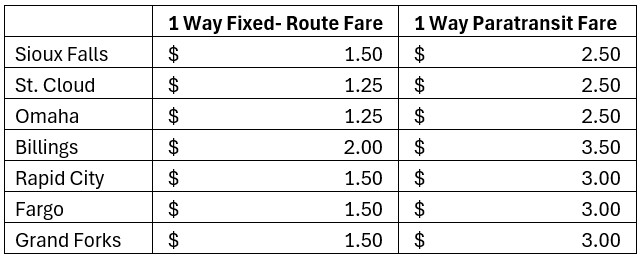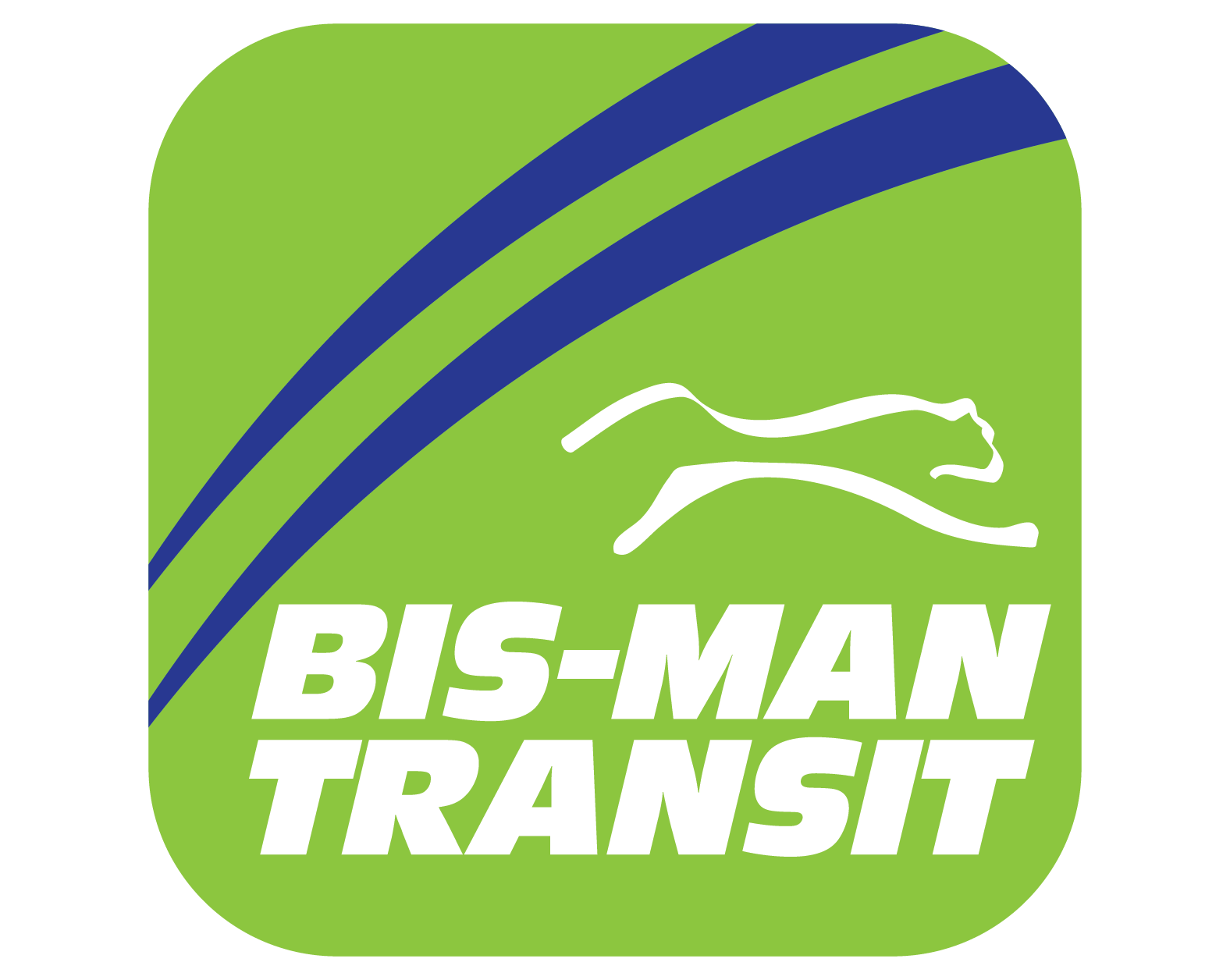Follow Us x
Our Mission:
Bis-Man Transit delivers valued public transportation, linking people, jobs and communities.
Our Vision:
Our vision is to provide safe, reliable, and efficient public transportation to support the overall quality of life in our communities.
Our Mission:
Bis-Man Transit delivers valued public transportation, linking people, jobs and communities.
Our Vision:
Our vision is to provide safe, reliable, and efficient public transportation to support the overall quality of life in our communities.
Frequently Asked Questions
Recently, a post on a local Facebook page encouraged the public to vote in favor of Measure One to support public transportation in our communities. The post generated a great deal of controversy and comments. Unfortunately, many of those comments spread misinformation.
We feel it is essential to address some of those comments.
Why are large buses used for the CAT Bus service?
The 29-foot buses purchased for our fixed-route bus service are built explicitly for frequent stops necessary for the services. The ADA-accessible ramps installed on these buses also engage much faster than their smaller counterpart used for paratransit service. Other fixed-route bus-specific features include location head signs, automatic vehicle location tracking software, and bike racks. None of these features can be found on our smaller paratransit buses. One of these buses' "useful life" is 12 years or 500,000 miles. Useful life is a term the Federal Transit Administration uses to reference the anticipated time frame a given vehicle model is expected to stay in service. Once useful life is achieved, buses typically require significant maintenance, including replacement engines, which cost upwards of $70,000. Breakdowns and service delays also become more and more frequent with older buses. The fixed route buses cost about $475,000; only 15% of this comes from local funds. The other 85% comes from the Federal Transit Administration and can ONLY be used for bus purchases. We are not able to transfer capital improvement grants to cover operating expenses.
So why don't we use smaller buses like those used for paratransit service?
The 24-foot buses used for paratransit service are often referred to as "cutaways". The cost of a new cutaway bus is $160,000. This has doubled in the last last 5 years. These vehicles have a useful life of 5 years and 150,000 miles, meaning buses are being replaced more frequently than their fixed-route counterpart. Again, the full sale amount does not come from Bis-Man Transit's local funds. The federal portion covered is 85%, leaving the local match at 15%. The chart below shows the local portion difference of $47,250 for the initial purchase. If you consider the frequency of bus replacement, that difference is closer to $22,050 for two years less of service. So, for $22,050 more, we have vehicles that are built for high-frequency stops, resulting in lower maintenance costs. Additionally, the large buses have sufficient interior space for riders to bring groceries and strollers on board, allowing riders to transport their bikes. These limitations of smaller buses are important to consider in our decision-making process. Lastly, it's important to note that both paratransit and fixed-route buses have similar fuel economy.

What type of oversight does Bis-Man Transit have?
There was concern that the funding for the bus system is being mismanaged. Bis-Man Transit's operations are overseen by an Executive Director who directly reports to a Board of nine Directors. The Executive Director and Board maintain frequent and open communications with the City of Bismarck, the Metropolitan Planning Organization, the North Dakota Department of Transportation, and the Federal Transit Administration. Any capital purchase over $25,000 must be approved by the Bismarck City Commission. Any substantial service change or fare increase must be presented at a series of public hearings and meetings and approved by the Bismarck City Commission.
Bis-Man Transit undergoes a full audit annually. For the last four years, these audits have had zero findings, indicating all accounting practices are being followed, all funding is being spent on approved purchases, and proper records are being maintained. Every penny is accounted for. Monthly expenses are reviewed by the City of Bismarck Finance Department to ensure compliance. The Federal Transit Administration completes a Triennial Review of the business every three years. This review includes everything from procurement to Title VI to Drug and Alcohol Policies. The most recent review was completed in April of 2024, with extremely positive results. The full report will be published this summer. Lastly, the North Dakota Department of Transportation completes a full review of the business every three years. This review will take place in June of 2024.
As Bis-Man Transit is a non-profit organization, everything we do is subject to open records. If you aren't interested in requesting specific documents, the Bis-Man Transit Board of Directors meets monthly. These meetings are open to the public and can be attended either in person or virtually. Agendas and previous minutes can be found at bismantransit.com.
The issue is not the mismanagement of funds but the lack of funding to support the service. Inflation has significantly increased the annual bus service cost, while federal, state, and local funding has remained relatively stagnant.
Why don't we do away with the bus system and rely on Uber and Lyft vouchers?
In theory, this idea seems promising. Less capital expense is needed as the drivers own their own vehicles, and the driver also covers fuel. However, Bis-Man Transit provided 16,840 trips in the month of May alone. Are there enough drivers to support that type of capacity? What type of ADA-Accessible features do these vehicles have for our paratransit clients? Of those 16,840 trips, 7,441 were completed using our paratransit bus service, which is exclusive to the elderly and disabled populations. If every voucher cost $20, May alone would have resulted in a $336,800 expense, which likely would not have been reimbursed by any federal grants currently used to support most public transit operations. If ridership remained the same for 12 months, the total annual voucher expense would be $4,041,600. This is significantly greater than the funds the City of Bismarck and the City of Mandan provide to support the service. Bismarck's local funding for 2024 is anticipated to be $1,508,715, and Mandan's is $246,723. As you can see, local funding alone could only support a fraction of the cost of a voucher system with the current ridership needs. Additionally, with Uber and Lyft, there is no guarantee of availability or price, meaning those in desperate need of transportation may be stuck at home without any way to get to work or doctor appointments or may need to pay much more out of pocket than they can afford.
Why doesn't Bis-Man Transit ask for donations or look for additional grants?
Annually, Bis-Man Transit has run a donation request campaign with very little success. Donations for the service are extremely sparse and unreliable. All funding is wonderful, but the service needs reliable, long-term funding rather than one-time payments. One-time payments cannot be budgeted for. Therefore, service cuts continue to be a topic of discussion year after year. We receive federal operating and capital grants, state aid, and local mill levy funds and have applied for every private grant we have found that we qualify for. The majority of federal and private grants available are not for operating expenses. This is where Bis-Man Transit needs the most assistance. We constantly encourage advocates and Board members to share any potential grants we may qualify for. In the last four years, Bis-Man Transit has applied for the following grants: Otto Bremer Foundation Grant, North Dakota Community Foundation Grant, AARP Community Challenge Grant, Urban Grant, American Rescue Plan Additional Assistance Grant, Section 5310 Enhanced Mobility of Seniors & Individuals with Disabilities Grant, and the Section 5339 Bus & Bus Facilities Program Grant.
Why not increase the bus fares to help pay for the service?
In 2023, the fixed-route and paratransit bus service received $303,030.82 in fare revenue. Even if we doubled the cost of riding both systems, additional operating funding would still be needed. Riding the CAT bus would cost $3.00 per trip, and paratransit would cost $6.00 per trip. This would cause a significant financial burden for low-income and elderly individuals on fixed incomes. Doubling the price of using the system would also mean we would be the most expensive public transportation system in the Midwest in an already high cost-of-living area. There are several studies dating back to the early 1990s indicating increases in fare costs discourage ridership, so it is highly unlikely we would see anywhere close to $600,000 in fare revenue even with a major price hike. It is estimated that a 10% increase in bus fares results in a 4% decline in ridership, per the American Public Transit Association.

